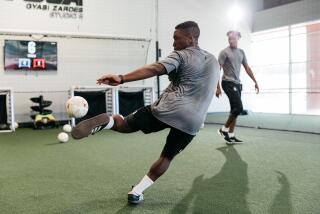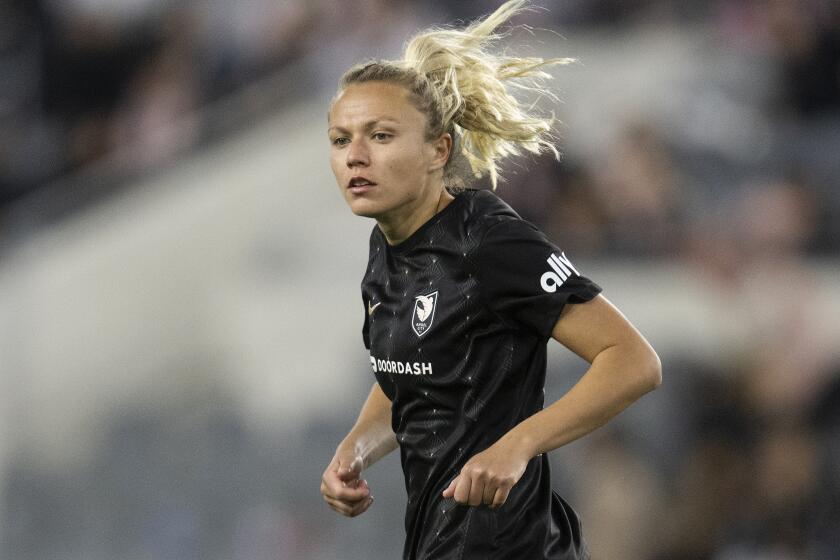Adjusting to a kinder, gentler soccer
Some years back, I stood at the edge of a field in Mexico City watching my older son play soccer.
The contest got my blood pressure going. I couldn’t help but yell an observation or two. “What’s that?” I barked after witnessing an errant pass. I guess I was a bit loud because my wife whispered over my shoulder: “Down, tiger.”
These days, in a Los Angeles suburb with tree-lined streets, I watch my son play and don’t even call out his name. I never say a critical word, and rarely does any other parent. Instead, there is much polite clapping and repetition of the phrases “Nice try!” and “Good effort!”
In the American Youth Soccer Organization, that creation of Southern California suburbia that introduced many of us to the “soccer mom,” it’s all about the kids having fun. We’re not supposed to care who wins, really.
All this mellowness took a little getting used to.
For years, I lived in Latin American countries where insults were hurled freely at players and referees. Once, in Buenos Aires, I saw a boy of about 9 call a referee an especially colorful, anatomical curse word. At the stadiums, fans stood behind the goals, blasting horns and shouting out ribald cheers.
You can’t do any of that in AYSO.
During my first youth game at a South Pasadena field, I stood behind the goal and whooped “Yes!” when my son’s team scored. A moment later, the referee walked over to me and said in the polite but stern voice of a good cop: “You can’t cheer if you sit behind the goal.”
I must have looked perplexed, because one of the moms sitting next to me explained. “Yeah, that’s a rule. They say cheering intimidates the goalkeeper.”
The little soccer hooligan inside me wanted to say: “Of course it does. That’s the whole point!”
In the context of American suburbia and AYSO culture, my little soccer hooligan is a big jerk. And I’ve happily put him on leave. “There are more than 650,000 children playing AYSO soccer,” says the manual the league gave me when I volunteered to referee. “And each one of those children has the right to a safe, fair, fun and positive environment.”
How could I possibly argue with that?
Coming back to the United States and its youth soccer fields, watching the moms with sliced oranges and other healthful snacks and the quiet dads sitting in their folding chairs, I’ve been struck by one of those insights about home that comes when you’ve been away a long time.
You hear a lot of stories about “ugly American” sports parents. And even women soccer players here have been known to lose their heads and beat up their rivals.
But my kids’ South Pasadena league is a jewel of the American middle class. Kids and parents of all colors gather there, and hundreds of girls play on fields alongside the boys. This mixing of races and genders takes place more smoothly here than in just about anywhere in the world.
We’ve collectively internalized the egalitarian credos of the civil-rights and women’s movements. That’s why the AYSO manual talks about fun as a “right.”
Fairness is so deeply ingrained in our psyches, in fact, we can’t tolerate the idea of any kid being left out -- even if she has two left feet or if he falls down every time he tries to kick the ball.
AYSO embraces a democratic view of sports -- “open registration” to any child no matter the skill level. It’s a place where parents accept a kinder, gentler way of sports. And for some of us hot-blooded dads, this means learning a whole new set of rules.
“I was a little too intense at first during my first years,” said Jorge Cacho-Sousa, a native of Peru who’s been coaching in, and helping to run, the South Pasadena league for 25 years. “For me, it was a big adjustment. . . . In Latin America, if you weren’t really good, you weren’t accepted as a player.”
Founded in Torrance in 1964, AYSO took off in the 1970s as an alternative to tackle football.
The more intense version of the sport for American kids is known as “club soccer.” Parents who think their son or daughter is a prodigy take their kids to those leagues, even though there’s no guarantee they’ll play every game.
In AYSO, the best players often take a seat on the bench so that kids with less ability get an equal chance to play.
Other things happen on AYSO fields, too, that would turn heads anywhere else soccer is played.
All players drop to one knee, as if in prayer, every time the game stops for an injury, no matter how trivial.
Early in the current season, after our team went ahead 5-0, I heard my younger son’s volunteer coach, Bob Gutzman, yelling “Left feet only, guys! Left feet!”
Later Gutzman explained the unwritten AYSO rule: When a team takes a big lead, the winning coach tells his or her players to pass with their left feet and to shoot only from behind a line that’s 18 yards from the goal.
The soccer purist in me might be mortified by that rule, akin to telling basketball players they can shoot only one-handed three-pointers. But the dad in me is glad it’s there. So is Gutzman.
“It’s not fun for anyone when a game gets out of hand,” he said. “We don’t want to humiliate the other team.”
Gutzman, a 44-year-old real estate consultant, is a pretty good player himself. He’s played in hyper-competitive U.S. leagues where they use dirty tricks like stepping on opponents’ feet to keep them from jumping to head the ball.
It’s not something he’d ever teach a kid in AYSO.
After all, he said, some parents bring their children to the league on the advice of therapists and doctors, as a way “to learn to control their aggression.”
In the democratic AYSO, there’s room for kids who are “learning to feel comfortable in their bodies,” and also for talents like Landon Donovan, who grew up playing in AYSO in Southern California and became arguably the greatest player the U.S. has ever produced.
Watching silently -- for the most part -- as my sons play, I’ve noticed one thing: They seem to be having more fun than they used to.
So I think I’ll keep that little soccer hooligan locked up longer -- at least until the World Cup starts next summer.







